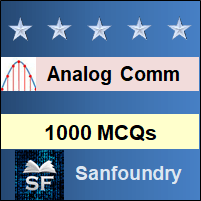
Analog Communications Multiple Choice Questions Highlights
- 1000+ Multiple Choice Questions & Answers (MCQs) in Analog Communications with a detailed explanation of every question.- These MCQs cover theoretical concepts, true-false(T/F) statements, fill-in-the-blanks and match the following style statements.
- These MCQs also cover numericals as well as diagram oriented MCQs.
- These MCQs are organized chapterwise and each Chapter is futher organized topicwise.
- Every MCQ set focuses on a specific topic of a given Chapter in Analog Communications Subject.
Who should Practice Analog Communications MCQs?
– Students who are preparing for college tests and exams such as mid-term tests and semester tests on Analog Communications.- Students who are preparing for Online/Offline Tests/Contests in Analog Communications.
– Students who wish to sharpen their knowledge of Analog Communications Subject.
- Anyone preparing for Aptitude test in Analog Communications.
- Anyone preparing for interviews (campus/off-campus interviews, walk-in interview and company interviews).
- Anyone preparing for entrance examinations and other competitive examinations.
- All - Experienced, Freshers and College / School Students.
Analog Communications Chapters
Here's the list of chapters on the "Analog Communications" subject covering 100+ topics. You can practice the MCQs chapter by chapter starting from the 1st chapter or you can jump to any chapter of your choice.- Elements of Communication System
- Amplitude Modulation
- Double Sideband Suppressed Carrier Modulation
- SSB Modulation
- VSB Modulation
- Side Band Techniques
- Angle Modulation
- Modulation
- Phase Locked Loop & Pulse Modulation
- Baseband Data Transmission
- Multiplexing & Sampling of Bandpass Signal
- Noise
- Receivers & Transducers
1. Elements of Communication System
The section contains multiple choice questions and answers on information source, transmitter, receiver and channel.
|
|
|
2. Amplitude Modulation
The section contains questions and answers on frequency domain description, single tone modulation, am waves representation and power relations, fdm system, am waves generation, detection and problems, reducing distortion methods, power calculations, balanced modulator, envelope detector and linear modulation.
3. Double Sideband Suppressed Carrier Modulation
The section contains MCQs on time domain description, dsbsc waves generation and coherent detection, hilbert transform, costas loop, dsbsc problems, quadrature carrier multiplexing and dsbsc demodulation.
4. SSB Modulation
The section contains multiple choice questions and answers on single side band transmission, ssb-sc representation in time and frequency domain, ssb-sc generation and demodulation, ssb applications, frequency discrimination method, filter method with advantages and disadvantages, phase shift method, vsb generation and applications.
5. VSB Modulation
The section contains questions and answers on modulation and demodulation of vsb modulated waves.
|
|
|
6. Side Band Techniques
The section contains MCQs on am sc waves spectrum, ssb with large carrier, non linear device, chopper and switching circuit.
|
|
|
7. Angle Modulation
The section contains multiple choice questions and answers on frequency modulation and its types, multitone wideband fm, transmission bandwidth, fm stereo multiplexing, direct and variation method, foster seely, zcd, reactance modulator and varactor diode.
8. Modulation
The section contains questions and answers on frequency translation, frequency division multiplexing, antenna practicality, noise reduction and narrowbanding.
|
|
|
9. Phase Locked Loop & Pulse Modulation
The section contains MCQs on phase comparator, pam transition, pulse modulated system noise and pwm.
|
|
|
10. Baseband Data Transmission
The section contains multiple choice questions and answers on baseband channel and intersymbol interference.
|
|
|
11. Multiplexing & Sampling of Bandpass Signal
The section contains questions and answers on multiplexing, digital and time division multiplexing, sampling, synchronous and asynchronous tdm.
|
|
|
12. Noise
The section contains MCQs on noise in am and fm, noise for dsb-sc, ssb-sc and am waves, threshold effect, phase modulation noise, comparisons between pm and am, fm and pm.
|
|
|
13. Receivers & Transducers
The section contains multiple choice questions and answers on heterodyne and superhetrodyne receiver, rf mixing, am and fm receiver, pre and de emphasis, agc, amplitude limiting and transducers need.
|
|
|
Wish you the best in your endeavor to learn and master Analog Communications!
